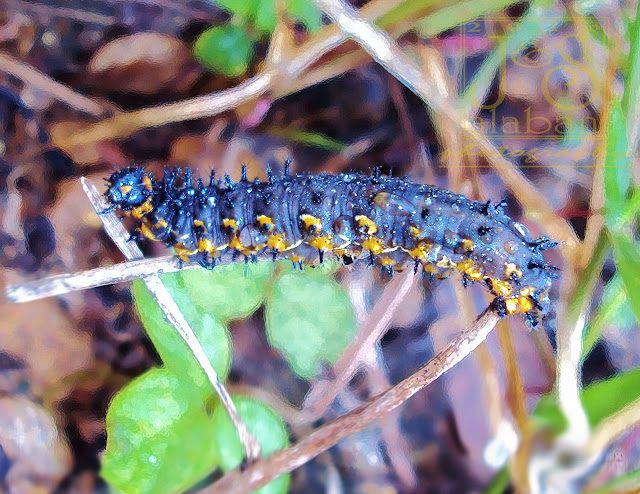Junonia orithya is a nymphalid butterfly with many subspecies occurring from Africa, through southern and south-eastern Asia, and in Australia. In India its common English name is the Blue Pansy, but in southern Africa it is known as the Eyed Pansy as the name Blue Pansy refers to Junonia oenone.In Australia this butterfly is known as the Blue Argus.
Junonia orithya is a nymphalid butterfly with many subspecies occurring from Africa, through southern and south-eastern Asia, and in Australia. In India its common English name is the Blue Pansy, but in southern Africa it is known as the Eyed Pansy as the name Blue Pansy refers to Junonia oenone. In Australia this butterfly is known as the Blue Argus.
The withered tip of the host plants branch makes
a good disguise for the caterpillar.
Male upperside : somewhat more than half the fore wing from base velvety
black, apical half dull fuliginous ; cell-area with or without two
short transverse orange bars ; a blue patch above, the tornus; the outer
margin of the basal black area obliquely zigzag in a line from the
middle of costa to apex of vein 2, including a large discal, generally
obscure ocellus, which, however, in some specimens is prominently ringed
with orange-yellow. Beyond this a broad while irregularly oblique
discal band followed by a short oblique preapical bar frm costa ; a
small black orange-ringed ocellus beneath the bar, a subterminal
continuous line of white spots in the interspaces and a terminal
jet-black slender line; cilia alternately dusky black and white. Hind
wing blue shaded with velvety black towards base; a postdiscal black
white-centred orange and black-ringed ocellus in interspace 2, a round
minutely white-centred velvety black spot (sometimes entirely absent) in
interspace 5; the termen narrowly white, traversed by an inner and an
outer subterminal and a terminal black line ; cilia white.
Female. Similar, with similar but larger and more clearly defined ocelli
and markings ; the basal half of the fore and hind wings on the
upper-side fuliginous brown, scarcely any trace of blue on the hind
wing. Antennae brown, head reddish brown, thorax and abdomen above
brownish black: palpi, thorax and abdomen beneath dull white.


Host plants
These are some of the host plants based on my own observations.
Above photo is Stachytarpheta jamaicensis it's a species of plant in the Verbenaceae family. Native throughout the Caribbean, the species is commonly known as blue porterweed or Jamaica vervain. It is pantropical, being found in the Indian Subcontinent, Southeastern Asia and West Tropical Africa, where it is known as Indian Snakeweed and Nettle-leaved vervain, formerly thought to be a separate species (Stachytarpheta indica). It is usually found along country roadsides and it grows also well as a ruderal plant on disturbed terrain. It is an invasive species in some places.
This plant can be also found on St. Croix, where it is locally known as "worrywine".


















No comments:
Post a Comment